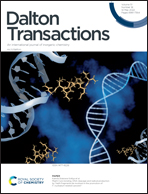Theoretical unraveling of the separation of trivalent Am and Eu ions by phosphine oxide ligands with different central heterocyclic moieties†
Abstract
The treatment of nuclear spent fuels, especially the separation of minor actinides, is an imperative task for the healthy development of the nuclear industry. Up to now, it still remains a worldwide challenge to separate trivalent An3+ from Ln3+ because of their similar chemical properties. Therefore, investigating the mechanism behind the selective extraction of An3+ by theoretical methods is necessary. In this work, three phosphine oxide ligands with the same side structures but different bridging frameworks, Ph2PyPO, Ph2BipyPO and Ph2PhenPO, were investigated theoretically, and compared with each other using relativistic density functional theory. The results of QTAIM and MBO suggest that the Am–N bonds in the studied complexes have more covalent character than those in the Eu–N bonds, whereas the PDOS analysis indicates that more overlap exists between Am-5f and the Ph2PyPO's N-2p orbital than between Am-5f and Ph2BipyPO's N-2p, and Am-5f and Ph2PhenPO's N-2p orbital. However, the studied ligands all possess stronger affinities towards Am3+ than Eu3+, which partly results in the Am3+ selectivity towards Eu3+ in these three ligands. The calculated reaction free energy can reproduce the Am/Eu separation ability difference of three ligands well. This work offers some useful information for An/Ln separation of phosphine oxide ligands, and may help to design more efficient An3+/Ln3+ separation ligands.



 Please wait while we load your content...
Please wait while we load your content...